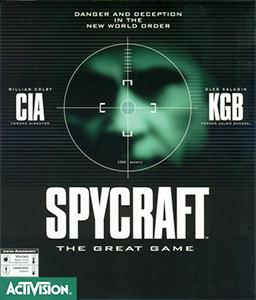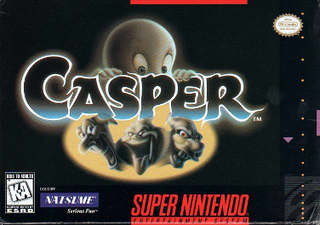
Star Trek: 25th Anniversary is an adventure video game developed and published by Interplay Productions in 1992, based on the Star Trek universe. The game chronicles various missions of James T. Kirk and his crew of the USS Enterprise. Its 1993 sequel, Star Trek: Judgment Rites, continues and concludes this two-game series.

Blood is a 3D first-person shooter video game developed by Monolith Productions and published by GT Interactive and developed using Ken Silverman’s Build engine. The shareware version was released for MS-DOS on March 7, 1997, while the full version was later released on May 21 in North America, and June 20 in Europe.

Dungeon Master II: The Legend of Skullkeep, also released as Dungeon Master II: Skullkeep, is the sequel to the dungeon crawler role-playing video game Dungeon Master. It was released in 1993 in Japan and in 1995 in other countries. It is available for DOS, Amiga, Macintosh, Sega CD, PC-9801, PC-9821, and FM Towns. A Sega Mega Drive version was planned but never released.

Toonstruck is a graphic adventure video game developed by Burst Studios, published by Virgin Interactive Entertainment and released in 1996 for DOS. The game features hand-drawn imagery and animated characters, but the protagonist Drew Blanc is represented as a video-captured live action character interacting with the cartoon world around him. In the game, Blanc is transported into the cartoon world he created while suffering from a creative block. Blanc is accompanied by his animated sidekick Flux Wildly.

Broken Sword: The Shadow of the Templars is a 1996 point-and-click adventure game developed by Revolution Software. It is the first in the Broken Sword series, co-written and directed by Charles Cecil. The player assumes the role of George Stobbart, an American tourist in Paris, as he attempts to unravel a deep conspiracy involving a sinister cult and a hidden treasure, seeing him travel to various locations around Europe and the Middle East. The game's storyline was conceived to feature a serious tone and heavily influenced by research on Knights Templar by Cecil, but was also interlaced with humor and graphics in the style of classic animated films.

Dragon Lore: The Legend Begins, is a point-and-click adventure game released in 1994 by Cryo Interactive for MS-DOS, and later ported to the 3DO video game console. The game was a commercial success, with sales of 300,000 units by 1997. An emulated version was released for Microsoft Windows and macOS in 2013.

Time Commando is an action-adventure video game developed by Adeline Software and published by Electronic Arts in Europe, Activision in America, and Virgin Interactive Entertainment and Acclaim Entertainment (Saturn) in Japan.

Normality is a 3D graphic adventure, released in June 1996 by Gremlin Interactive. All cut-scenes in the game are pre-rendered. The game's engine was later used in the game Realms of the Haunting. It was re-released in 2011 with Microsoft Windows support on GOG.com, with macOS support following in 2013 and Linux support in 2014.

Frankenstein: Through the Eyes of the Monster is a point-and-click adventure video game that stars Tim Curry as Dr. Frankenstein, and has the player controlling a newly created Frankenstein monster. Other cast members include Robert Rothrock as the voice of the monster, Rebecca Wink as villager Sara, and Amanda Fuller as Gabrielle, the monster's daughter. It used full motion video clips and 3D CGI graphics similar to Myst. The game was developed by Amazing Media and published by Interplay Entertainment Corp for the PC in 1995 and for the Sega Saturn in 1997. The game was given a "Teen" rating by the Entertainment Software Rating Board, but was originally rated as K-A. A port for the Atari Jaguar was in development but never released.

Temüjin is a 1997 computer game developed and published by SouthPeak Interactive.

Spycraft: The Great Game is an adventure CD-ROM game published by Activision in 1996. It details the attempted assassination of the President of the United States and the CIA and SVR attempts to save him. Although the game was not approved by either organization, it tends to favour realism due to its coordination with former CIA director William Colby and former KGB Major-General Oleg Kalugin, who also appear in the game as themselves. The game also stars James Karen, Dennis Lipscomb, Joseph Ruskin, Tim De Zarn, Kirk B.R. Woller, Allan Kolman, Chase Masterson and Charles Napier in prominent roles.

Broken Sword II: The Smoking Mirror is a point-and-click adventure video game developed by Revolution Software for Microsoft Windows and PlayStation. It was re-released on Microsoft Windows, OS X and iOS as a remastered edition in 2010 and on Android in 2012. It is the second installment in the Broken Sword series, and the first game in the series that does not follow the Knights Templar storyline. The player assumes the role of George Stobbart, a young American who is an eyewitness to the kidnapping of his girlfriend Nicole Collard.

Casper is a series of action-adventure games based on the 1995 film of the same name. Two different games were released in 1996 and 1997 for the Super Nintendo Entertainment System, by different publishers, in different regions. A third game was released for the 3DO, Sega Saturn, PlayStation, and Game Boy Color, published by Interplay Productions. There was also a Game Boy game developed by Bonsai. A PC game, Casper: The Interactive Adventure, and a Game Boy Advance game, simply titled Casper, were released in 1997 and 2002 respectively serving as sequels.

Lands of Lore: Guardians of Destiny is a 1997 action role-playing game, second installment of the Lands of Lore series, a sequel to Lands of Lore: The Throne of Chaos. It brought about a drastic change in gameplay style from its predecessor, opting away from the original's D&D turn-based style in favor of more action elements. A sequel, Lands of Lore III, was released in 1999.

The Legend of Kyrandia: Book Three - Malcolm's Revenge is a 2D point-and-click adventure game, developed by Westwood Studios and published by Virgin Interactive Entertainment in 1994. It is the sequel to The Legend of Kyrandia: Hand of Fate, and the third and final game in the Fables & Fiends series. The game sees players take on the role of the antagonist from the first game in the series, who begins plotting his revenge against those who thwarted him, only to find himself eventually seeking to prove his innocence of a murder he did not commit.

Litil Divil is a video game released by Gremlin Graphics Software in 1993. The game stars Mutt, a dog-like devil in the Underworld whose goal is to obtain the "Mystical Pizza of Plenty" from the Labyrinth of Chaos. Litil Divil's release was delayed several times, and the game was initially advertised in magazines under the name Little Divil.

Actua Golf is a sports video game developed and published by Gremlin Interactive for PlayStation and Sega Saturn.

King's Quest: Mask of Eternity is a hybrid point-and-click adventure and action-adventure video game developed and published by Sierra Studios in 1998. It was the eighth official game in the King's Quest series, the first and only game in the main series where the main character is neither King Graham nor a member of his family, as well as the first in the series to use a full 3D engine as opposed to the 2D cartoon or pixel style of the earlier games and the first to omit the sequel numbering system on box artwork and title screen.

Screamer 2 is a video game developed by Milestone and published by Virgin Interactive Entertainment, released in 1996 on September 30 in North America and November 15 in Europe. It is the second game in the Screamer series. Unlike its predecessor, which drew heavily from Namco's Ridge Racer, Screamer 2 moved towards a rally-oriented style, replacing the six high-performance road cars of the previous game with four rally cars. The game supports up to two players using a split screen and up to four players over a network. A sequel, Screamer Rally, was released in 1997.

Pro Pinball: Fantastic Journey is an action video game developed by Cunning Developments, published by Empire Interactive and distributed by Take-Two Interactive for Microsoft Windows and PlayStation. It is the fourth game in the Pro Pinball series. Elements of the game include combinations of Victorian era settings, steam powered machinery, steampunk style nautical adventures, and fictional islands.



















